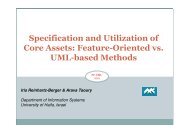booklet - ER 2011
booklet - ER 2011
booklet - ER 2011
You also want an ePaper? Increase the reach of your titles
YUMPU automatically turns print PDFs into web optimized ePapers that Google loves.
MoreBI Keynote 1: Modeling management information<br />
Arthur Overlack (Altran)<br />
Date: Monday 11:00-12:30<br />
Room: Louise 1b<br />
Chair: Ivan Jureta (Université de Namur, Belgium)<br />
Workshop Keynote Abstracts<br />
Arthur Overlack After his university degree in Aerospace Technology Mr. Overlack worked in the<br />
Aircraft Industry for 8 years in materials management, after sales support and Marketing (Fokker<br />
50). After 4 years of HR consulting with Mercury Urval, he joined Cap Gemini, working with<br />
clients in many industries and (semi-)government. Assignments varied from Business Intelligence<br />
consultancy to large scale change management and strategy development in banking , insurance,<br />
industry and trade.<br />
Mr. Overlack joined Altran in 2005 and is now responsible for development of (Group) Solutions and deployment<br />
in the Netherlands. At Altran Group level he is Global Practice Manager for BI, responsible for managing and<br />
supporting the development and deployment of BI solutions by Altran in Europe.<br />
Throughout his career, Business Intelligence has been a recurring subject. Since the emergence of Windowsbased<br />
BI systems and maturing Data Warehouse tools, technology became less important and more focus was<br />
needed on developing requirements for BI systems. The quest for the nature of management and in particular<br />
the contents and character of management information led to the development of the Business Control Matrix,<br />
as a means to translate management notions about control mechanisms into data-structures that would yield<br />
effective management information.<br />
Abstract Hundreds of models have been designed in the past to represent management processes, most of<br />
them dedicated to a specific aspect to be managed. To model management information is difficult, since there<br />
is a gap between managerial thinking and the way relevant data are to be identified, stored, retrieved and<br />
assembled to make information.<br />
The essence of the problem is to find a way to represent manager’s needs, allowing managers to validate<br />
the correctness and completeness, while allowing IT staff to use it as an unambiguous input to build a data<br />
warehouse and customize a presentation tool, of which there are many in the market.<br />
The method to model management information needs, must be verifiable and easy, to realize a short leadtime<br />
and to generate and strong commitment of future users, to facilitate adoption of the system to be built.<br />
Also, it must allow adaptation in consecutive periods of adjustment, if new insights lead to extension of the<br />
management information requirements.<br />
The method of the BCM aims to provide a relatively simple method to bridge the gap between the way<br />
managers think, using systems theory and the way IT specialists deal with data warehouse design. Also some<br />
other features of the BCM allow cross-checking the consistency of management mechanisms across boundaries<br />
in the organization and verification of the consistency of data- and dimension definitions.<br />
The method is meant to be transferred to the standing organizations, in order to enable them to expand and<br />
improve their model continuously.<br />
41




